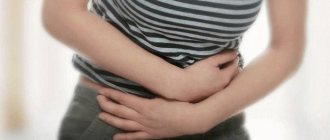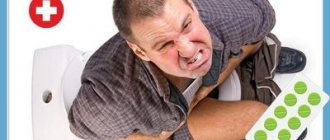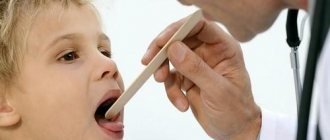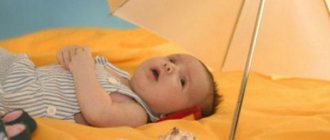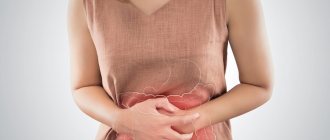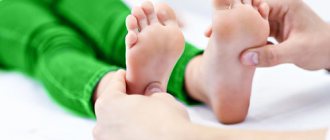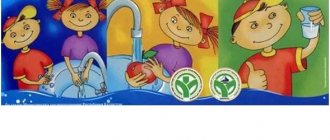Causes
Diarrhea accompanied by fever is most likely caused by an intestinal infection. According to the type of pathogen, intestinal infections are divided into bacterial, viral and protozoal. (2)
The most common bacterial intestinal infections include the following.
- Dysentery is an infection caused by bacteria of the genus Shigella, which affects the mucous membrane of the large intestine. The disease is characterized by repeated diarrhea mixed with blood, fever up to 38-39 ° C, vomiting and loss of appetite.
- Salmonellosis is an intestinal infection caused by Salmonella. With this disease, diarrhea may be greenish in color, vomiting is observed, and the temperature rises to 38°C.
- Botulism is a disease that develops when botulinum toxin, a waste product of the bacteria Clostridium botulinum, enters the body. In addition to diarrhea and vomiting with fever, the disease is characterized by damage to the nervous system with impaired visual and other functions.
Diarrhea can also be caused by viral infections - and viruses are the first leading cause of acute intestinal infections in children. (3)
- Rotavirus infection plays a leading role in this regard. “Intestinal flu” manifests itself in the form of an increase in temperature to 38-39°C, diarrhea, and vomiting.
- Norovirus infection competes with rotaviruses in terms of disease frequency, and it develops faster. Symptoms: diarrhea, fever, fever, repeated vomiting. (4)
- Adenoviral infection. With this disease, the virus affects the mucous membrane of the intestines, upper respiratory tract, and eyes. Against the background of elevated temperature, the symptoms of a cold (sore throat, cough, runny nose) are accompanied by abdominal pain and diarrhea.
- Enterovirus infection also manifests itself in the form of symptoms characteristic of influenza, that is, sore throat, runny nose, cough, to which are added vomiting, diarrhea, and bloating.
Intestinal infections can also be caused by protozoa, for example, giardia (giardiasis), amoebas (amoebiasis), blood flukes - trematodes (schistomatosis).
However, other reasons cannot be ruled out. Diarrhea with high fever can also occur with a number of other diseases.
- Food poisoning from expired products (containing a large number of bacteria or their toxins - so-called toxic infections).
- Helminthiasis.
- Diseases requiring surgical intervention (acute appendicitis, intestinal obstruction).
- Other infectious diseases (measles, chickenpox, etc.).
In children under one year of age, diarrhea with fever can be caused by teething. However, this happens extremely rarely. More often, parents of the baby observe not diarrhea, but mushy stool. Usually after 2-3 days the temperature drops and a new tooth erupts in the mouth.
Food poisoning
It's easy to get poisoned! Snacking on the run, improper storage of food, spoiled or obviously suspicious food, and diarrhea is not long in coming! Doctors distinguish 3 types of poisoning:
- Microbial or bacterial
- Chemical
- Poisons of plant or animal origin
The first symptoms of bacterial poisoning begin to appear at least 2 hours, and maximum 24 hours after ingesting low-quality products or chemicals. With adequate treatment, the disease lasts no more than 3 days. Symptoms of food poisoning:
- Vomiting and nausea
- Chills
- The temperature may not increase, but jumps to critical values are possible
- Diarrhea
- Stomach ache
First aid for food poisoning:
- Rinsing the stomach and intestines with clean boiled water
- Avoid dehydration - drink frequently, but in small portions
- Light diet food
- If diarrhea does not subside, and the temperature rises from 37o C and above, you need to consult a doctor.
What to do and how to stop
In most cases, diarrhea with fever is of infectious origin. If your child has repeated diarrhea with high fever, you should immediately consult a doctor.
Before the doctor arrives, the baby can be given an antipyretic, for example, paracetamol or ibuprofen. Since during diarrhea the body loses a lot of fluid, which can be dangerous in children under 3 years of age, the child must be given any liquid he likes (fruit drink, tea, diluted juice), cooled boiled water, or even better - glucose-salt pharmaceutical solutions , suitable for age. Liquids should be given in small doses at intervals of 8-12 minutes. (5)
The causative agent of the infection can be determined indirectly clinically, or by performing a stool test. There are two types of analysis: bacterial culture (this takes about 7 days) and PCR screening (will be ready in 1-2 days, as a plus - it includes the identification of viral pathogens). Since your child needs immediate help, the doctor will prescribe treatment based on a thorough examination. The success of treatment largely depends on how quickly measures were taken. In the classic form of diarrhea, it is enough to give the child a glucose-saline solution; sorbents and probiotics have a low degree of clinical effectiveness. In practice, experienced doctors use only Smecta, and Enterol as a probiotic. In case of a bacterial infection, antibacterial drugs may be prescribed.
Among other things, some doctors recommend giving children zinc supplements, which will also help reduce the risk of recurrence of diarrhea over the next three months. However, it should be borne in mind that research on the use of zinc in cases of diarrhea is incomplete - in any case, it is worth consulting with your doctor. (6)
Photo: pixabay.com
Dehydration is the most dangerous condition that can develop in a child with diarrhea, so carefully monitor your child and if you notice any of the following signs, call an ambulance immediately:
- the child is lethargic, he is drawn to sleep both during the day and at night. Children's games and other activities are not easy for him;
- after a relative improvement in the condition - a decrease in temperature and cessation of diarrhea - vomiting suddenly begins and the temperature rises again;
- anxiety, increased irritability, or, on the contrary, decreased level of consciousness, lethargy;
- the baby refuses to eat;
- the child drinks greedily or, on the contrary, refuses water;
- the baby urinates less than 5 times a day, the urine is dark in color;
- the child has cracks on his lips and cries without tears;
- sunken eyes;
- The skin fold straightens out slowly. (7)
For intestinal infections, as well as for two weeks after recovery, you must follow a diet. Milk and dairy products should be excluded from the diet (can be replaced with probiotic fermented milk products, (8) but in case of severe diarrhea, fermented milk should also be excluded, as well as other lactose-containing products), sweets, fried, smoked, fatty foods.
It is recommended to give your child light soups, porridge (buckwheat, oatmeal, rice), boiled vegetables (carrots, broccoli), crackers, steamed cutlets, baked apples, bananas, tea, compote.
Why does the consistency of stool change?
The consistency of stool is determined by its water-holding capacity, i.e., the amount of unbound, “free” water4. If normally the water content in stool is 60–70%, then with diarrhea it increases to 85–95%18.
To understand why a child has loose stools, let's imagine the functioning of his digestive system. Every day, approximately 1.5-2 liters of liquid2 enter the gastrointestinal tract - this is how much we usually drink or consume in the form of liquid food. Digestive juices are added to this volume, and 4-5 times more fluid enters the small intestine than the volume of liquid that came in the form of drinks or food. Most of this fluid is absorbed in the lower small intestine, where stool formation begins. But the final “squeeze” of feces occurs in the large intestine, which, however, is capable of absorbing only 5 liters of water. Therefore, when more than five liters2 enter the colon from the small intestine, or stool moves faster9, the amount of “free” water in the stool increases9 and it becomes liquid.
We have described the mechanism of development of diarrhea2, now let’s talk about the reasons that trigger these mechanisms.
to come back to the beginning
Prevention
The main cause of intestinal infections is failure to comply with personal hygiene rules. From an early age, a child must be taught to wash his hands before eating, after using the toilet and walking outdoors.
Food products must be subjected to thorough heat treatment. Wash fresh fruits and vegetables thoroughly in running water before eating.
Avoid fast food in dubious establishments.
You can also get vaccinated against rotavirus - consult your doctor about this.
“Unfortunately, even after taking all preventive measures, it is difficult to completely eliminate infection,” notes pediatrician Nikolai Komov . — It is important to understand that the main task of parents before the doctor arrives is to begin rehydration, that is, copious amounts of glucose-saline solutions. In most cases, this is enough. I also note that the most “dehydrating” and acute infection in childhood in our country is rotavirus infection, which is prevented by timely vaccination. The first vaccination should be given before 12 weeks of life.
Compliance with hygiene measures for diarrhea in a 1 year old child
Your baby's toys should be washed daily with laundry soap.
If your baby has frequent bowel movements, you need to pay special attention to the hygiene of the area around the anus. It becomes irritated, redness and itching appear, and the child is sensitive to attempts to touch the skin.
To prevent this irritation from occurring, you need to wash the baby more often or wipe the area around the anus with wet wipes, lubricate with baby cream or dry the skin with powder.
Adults caring for a baby with symptoms of diarrhea should wash their hands with soap more often after hygiene procedures, before feeding, and taking medications. Children's underwear should be washed separately from adults' underwear. Bed and underwear are ironed with a hot iron. The room where the child is located is regularly ventilated and wet cleaned with disinfectants.
Popular questions and answers
When a baby’s stomach “twists”, such unpleasant symptoms appear, many parents – especially inexperienced ones – get scared. Because of this, they may miss something or, on the contrary, do unnecessary actions. Pediatrician Nikolai Komov answers the most popular questions.
What are the dangers of diarrhea besides dehydration?
When we talk about mild foodborne illnesses (gastroenteritis), we can limit ourselves only to desoldering. In this case, the most threatening consequence will be dehydration. But if we are talking about bacterial infections, complications may arise here. There are different groups of pathogenic E. coli that can cause invasion (damage to the intestinal wall), hemolytic-uremic syndrome (damage to the kidney tubules) is a dangerous, almost resuscitation condition, but, fortunately, such cases are rare. In addition, there are diseases such as dysentery and typhoid fever. These diseases are dangerous for the entire body. Fortunately, the sanitary and epidemiological service in Russia works well, and outbreaks of the disease can be quickly localized and treated.
How long can diarrhea be treated at home? How many days to wait?
If the general condition is good and there is no vomiting, you feed the child correctly, then it is enough to introduce a diet and observe. If diarrhea does not go away within 7-10 days (depending on the age of the child, the younger, the sooner you should see a doctor), then you need to discuss this with your pediatrician. Because in addition to standard viral infections and bacterial infections, there are parasitic ones, which can manifest themselves, including diarrhea. You need to see a doctor so that he can look at your stomach and take a medical history to understand whether it is definitely a mild infection.
How to recognize diarrhea in a baby, that is, to distinguish it from normal newborn stool, which can also be watery?
You need to look at the general condition and dynamics.
If before this the child had loose stools 4-5-10 times a day, then we can hardly talk about infection. If before this the child walked “largely” once every 3-7 days (and all this is the norm for a baby, especially in the first 6 months of life), and suddenly some loose stools appeared - this is most likely a symptom. In addition, any gastroenteritis is accompanied by systemic manifestations (lethargy, weakness, moodiness and fever (optional). Usually, an intestinal infection begins acutely due to some kind of contact (someone else in the environment has worsened their health, loose stool). If We excluded all of the above, and we see that the child’s health is good, and the stool is either normal or liquefied, then in general there is no need to worry .
- Bulletin of the World Health Organization 2022. URL: https://www.who.int/news-room/fact-sheets/detail/diarrhoeal-disease
- Babayan M.L. Modern principles of treatment of acute rotavirus infection in children // Pediatrics (Appendix to the journal Consilium Medicum). 2018; 1. pp. 101-105. URL: https://cyberleninka.ru/article/n/sovremennye-printsipy-terapii-ostroy-rotavirusnoy-infektsii-u-detey/viewer
- Korneeva E.V. Diagnostic criteria for intestinal infections in children in the first months of life // Bulletin of SUSU. 2012; No. 8. pp. 74-76. URL: https://cyberleninka.ru/article/n/diagnosticheskie-kriterii-kishechnyh-infektsiy-u-detey-pervyh-mesyatsev-zhizni/viewer
- Usenko D.V., Gorelova E.A. Acute intestinal infections of viral etiology in children: diagnostic and therapeutic options // Medical Council. 2017; No. 9. pp. 86-91. URL: https://cyberleninka.ru/article/n/ostrye-kishechnye-infektsii-virusnoy-etiologii-u-detey-vozmozhnosti-diagnostiki-i-terapii/viewer
- Bekhtereva M.K., Komarova A.M. How you can help a child with fever // Difficult patient. 2022. No. 4. Volume 19. URL: https://cyberleninka.ru/article/n/kak-mozhno-pomoch-rebenku-s-lihoradkoy/viewer
- Acute diarrhea in Adults and Children: A Global Perspective // World Gastroenterology Organisation. 2012/ Acute diarrhea in adults and children: a global perspective // Recommendations of the World Gastroenterological Organization. 2012. URL: https://www.worldgastroenterology.org/guidelines/acute-diarrhea/acute-diarrhea-english
- Diarrhea. Based on WHO materials // Pediatric pharmacology. 2013. No. 3. Volume 10 (98-107). URL: https://www.pedpharma.ru/jour/issue/viewIssue/12/8
- Bekhtereva M.K., Ivanova V.V., Mukhina N.V. Fermented milk products in children's nutrition: preventive and therapeutic possibilities of use // Russian Bulletin of Perinatology and Pediatrics. 2017; 62(2). pp. 22-29. URL: https://cyberleninka.ru/article/n/kislomolochnye-produkty-v-pitanii-detey-profilakticheskie-i-lechebnye-vozmozhnosti-ispolzovaniya/viewer
- Diarrhea in Children // Johns Hopkins Medicine. URL: https://www.hopkinsmedicine.org/health/conditions-and-diseases/diarrhea-in-children
About the symptoms of childhood diarrhea
Bloating in babies can be a symptom of diarrhea.
In addition to, in fact, liquid, watery, as if “underformed” stool, the main symptoms of diarrhea in young children are usually:
- bloating and flatulence;
- discomfort in the colon area;
- characteristic rumbling in the abdominal cavity;
- frequent urge to defecate, which turns out to be false in at least half of the cases.
Depending on the cause that provoked diarrhea, this disease may be characterized by some specific symptoms.


